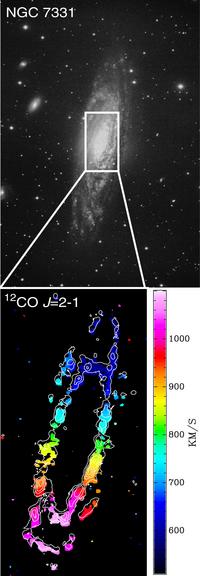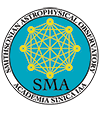 |
|
|
| SMA Research: Nearby Galaxies | ||||
|
Radio waves offer a particularly powerful means to probe the cool interstellar medium in nearby galaxies. Much of the interstellar medium in typical star forming galaxies is comprised of neutral atomic hydrogen (HI) which can be detected via its spectral line transition at 21-cm. This 21-cm transition was first detected by Harold Ewen and Edward Purcell in 1951, using a simple horn antenna located on the Harvard campus. Today the HI 21-cm line remains one of the most valuable tracers of the kinematics of nearby galaxies since it is not obscured by dust or starlight, and often it can trace the disks of galaxies beyond where their outermost stars are observed.
The interstellar medium of galaxies also contains a denser molecular gas component that emits radiation at millimeter and submillimeter wavelengths. Clouds of molecular gas collapse to form new stars and planets and are also thought to be one of the major fuel sources in the nuclei of active galaxies. The figure on the right shows an optical image of the spiral galaxy NGC 7331 compared with the warm molecular gas distribution observed with the SMA. The molecular gas is wrapped into a ring-like structure, with no convincing evidence for gas in the very center. Thus the fuel source for this active galaxy remains a mystery.
The molecular gas distribution can be deconvolved into a series of individual clumps with sizes on the order of giant molecular clouds (GMCs) with mass spectrums similar to that seen in other nearby galaxies such as M33 and M31. Detailed analyses such as this will lead to a better understanding of the processes involved in the evolution of star formation and AGN activity and their impact on galaxy evolution in general.
CfA:
ASIAA: Kazushi Sakamoto, Satoki Matsushita
Other Collaborators:
|

Top: An optical image of the SA(s)c LINER galaxy NGC 7331 from the Digitized Sky Survey. Bottom: A map of the molecular gas distribution obtained with the SMA (Petitpas et al. in prep.). White intensity contours are overlaided on colors representing the measured gas velocities, which clearly indicate rotation. | |||
|
|
